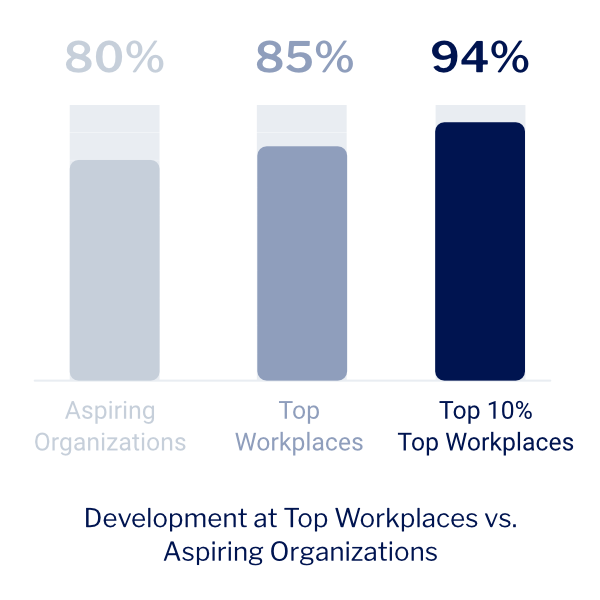Employee training is important because it dramatically improves productivity and performance by providing employees with necessary skills to carry out essential tasks, as well as increases their independence by equipping them with sufficient knowledge to complete their job without having to ask for help. Additionally, offering employee training and development opportunities enhances job satisfaction, increases potential for advancement within the company, and improves employee retention rates.
On-the-job training is a valuable tool for enhancing employee skills and productivity in the workplace, and can provide customised training, faster onboarding, and practical, hands-on experience. Improving the knowledge and skills of employees to match industry changes positively affects worker productivity, and can increase profits and efficiency of the organization.
Ultimately, employee training is crucial for an organization’s success and overall growth.

Credit: seismic.com
Benefits Of Employee Training
Blog Post Section:
Investing in employee training is an essential aspect of achieving organizational success. Employee training provides numerous benefits to both employees and employers. Here are the top benefits of employee training:
Improved Productivity And Performance
Employee training significantly boosts productivity and performance by teaching employees essential skills. When employees receive adequate training, they become more competent and efficient in completing tasks, often with higher quality output. This leads to increased productivity and reduces the likelihood of errors and workplace accidents.
Increased Independence And Confidence
Effective employee training increases independence and confidence, as employees receive the knowledge and skills needed to complete tasks without relying on assistance from colleagues or supervisors. This not only saves time but also boosts employee morale, as they feel more capable of performing their jobs and taking on more responsibilities.
Enhanced Job Satisfaction And Engagement
Investing in employee training can lead to enhanced job satisfaction and engagement levels. Employees who receive training feel valued by their employer, leading to increased motivation and engagement. As employees gain the knowledge and skills needed to perform their job functions at a high level, they typically experience a greater feeling of satisfaction in their role.
Improved Employee Retention
Employee training is crucial for retaining staff members. When employees feel equipped with the knowledge and skills needed to perform their jobs effectively, they tend to feel more loyal to their employer. Plus, training programs often include opportunities for advancement, which further strengthens employee retention rates.
Increased Potential For Advancement
Employee training leads to increased potential for advancement within an organization. The acquisition of new skills and knowledge positions employees well for taking on new responsibilities and roles within the company, leading to advancements in both rank and salary. This reduces the need for employers to look outside the organization to fill more senior positions.
Boost In Profits And Efficiency
Employee training results in a boost in profits and efficiency as employees become more skilled and efficient in their tasks. When employees possess the skills needed to complete tasks effectively and efficiently, productivity increases. This translates into higher levels of efficiency and higher profits for the organization.
Overall, employee training is critical for realizing organizational success. It leads to enhanced productivity and performance, increased independence, confidence, and satisfaction among employees, and ultimately boosts profits and efficiency.
Types Of Employee Training
Employee training is crucial for boosting productivity and performance by imparting essential skills to employees. It also helps to increase employee independence, making them adept at their jobs and reducing the need for external support. Continuous training opportunities can also enhance job satisfaction, boost productivity, and improve employee retention.
Employee training is a crucial part of the growth of any organization. With the right training, employees can acquire new skills and knowledge, develop better work habits, and improve overall productivity. Here are some types of employee training that organizations can offer:
On-the-job Training
On-the-job training is an effective way to provide practical, hands-on experience to employees. It involves learning by doing, where employees are trained on their job responsibilities and work alongside experienced colleagues or supervisors. On-the-job training can also help employees develop problem-solving skills and gain a deeper understanding of the company’s culture.
Formal Classroom Training
Formal classroom training is a structured and organized way to deliver training sessions to employees. It’s typically conducted in a traditional classroom setting, where a trainer presents information and conducts exercises to help employees retain knowledge. This type of training is beneficial for new hires, as it provides a comprehensive overview of the organization’s policies, procedures, and products.
Technology-based Training
Technology-based training is ideal for organizations with remote or geographically dispersed workforces. It involves using digital tools such as webinars, videos, and online courses to deliver training content. Employees can complete the training at their own pace, making it convenient and flexible.
Mentoring And Coaching
Mentoring and coaching involve pairing employees with experienced colleagues or managers who can guide and advise them in their personal and professional growth. This type of training is effective for developing leadership skills and improving job performance.
Cross-training
Cross-training involves training employees in different roles or departments within the organization. This type of training can be beneficial for developing a more versatile and adaptable workforce, as well as improving teamwork and collaboration.
Soft Skills Training
Soft skills refer to personal attributes such as communication, problem-solving, and time management. Soft skills training focuses on developing these attributes in employees to improve their interpersonal and communication skills, leading to better work relationships and increased productivity.
In conclusion, offering various types of employee training can greatly benefit an organization in terms of employee development, productivity, and overall success. By investing in the growth of its employees, an organization can create a culture of continuous learning and development.
Challenges In Implementing Employee Training
Implementing employee training can come with challenges such as assessing the effectiveness of the training and ensuring employee engagement. However, proper training is important as it equips employees with the skills they need to improve performance, increase job satisfaction, and overall productivity. Training also helps employees adapt to industry changes and promotes growth within the company.
Challenges in Implementing Employee Training
Employee training plays a vital role in enhancing productivity, job satisfaction, and employee retention. However, implementing employee training is not always a smooth process. There are several challenges that organizations face, hindering them from implementing effective employee training programs. In this section, we will discuss some significant challenges that organizations face while implementing employee training programs and their impact.
Budget Constraints
Budget constraints play a significant role in limiting organizations from providing the right kind of training to their employees. Inadequate funding can limit the type of training provided, the number of employees trained, and the overall effectiveness of the training. Developing and implementing comprehensive employee training programs require a lot of financial resources, and organizations may face difficulties in setting aside funds for this purpose.
Lack of Time
Time constraints can also pose a significant challenge to implementing effective employee training programs. Organizations have to juggle multiple tasks and responsibilities and finding the time to train employees can be difficult. Employees may also find it hard to dedicate time for training, especially if they have to balance it with their daily work responsibilities. Thus, organizations may need to find creative ways to incorporate training into daily work responsibilities to ensure effective employee training.
Resistance to Change
Change is hard, and many employees may resist it. Consequently, implementing new training programs can be challenging. Employees may resist change because they are comfortable with the current system and find it difficult to learn new methods or approaches. Employers need to understand and address employee resistance to ensure that they receive the utmost cooperation and enthusiasm needed for effective employee training.
Ineffective Training Methods
Ineffective training methods can result in a waste of time and resources without producing any tangible results. Training methods that fail to address and respond to the different learning styles and diverse needs of employees can lead to disengagement and a lack of motivation among employees. Organizations need to identify and implement the right training methods that work for their employees and lead to successful trainings.
Lack of Management Support
Lack of management support can also hinder the implementation of an effective employee training program. Management buy-in and support are crucial to the success of such initiatives. When management does not dedicate enough time or resources to support the training programs, employees may take that as a sign that the organization does not prioritize employee development and training.
Difficulty in Measuring Training Effectiveness
Measuring the effectiveness of employee training programs is critical to determining the value of such initiatives. However, measuring training effectiveness can be challenging if the appropriate metrics are not in place or if there are no clear objectives. Organizations need to invest in tools and techniques that help measure the effectiveness of their employee training programs accurately.
In conclusion, implementing employee training programs can be challenging for organizations due to reasons, including budget constraints, time constraints, resistance to change, ineffective training methods, lack of management support, and difficulty in measuring the training’s effectiveness. To overcome these challenges and ensure success, organizations need to invest in comprehensive training programs that address the specific needs of their employees while being mindful of budget and time constraints. Additionally, they should find innovative ways to incorporate training into day-to-day work and ensure management is fully supportive of these programs.

Credit: topworkplaces.com
Key Components Of Successful Employee Training Programs
Employee training programs are crucial for improving the knowledge and skills of workers to match the changes in the industry. Through effective training, employees can become more independent and productive, which can lead to improved job satisfaction, engagement, and retention.
Adequate training also increases the potential for growth and advancement within the company for employees.
Employee training is an essential aspect of the growth of any organization. To keep up with the needs of a dynamic industry, companies must invest in employee training programs that are effective and engaging. Here are some key components of a successful employee training program.
Defined Training Goals And Objectives
The first step in executing a successful employee training program is to define the training goals and objectives clearly. These goals should align with the company’s overall objectives and should be specific, measurable, attainable, relevant, and time-bound (SMART). It will help employees understand the purpose and relevance of the training program.
Customizable Training Programs
Customizable training programs are useful in addressing unique employee requirements. Based on the employee’s career level, experience, or department, the training program can be tailored to meet individual needs. Customizable training programs help employees to be more flexible and adaptable, empowering them to perform better in their roles.
Engagement And Support From Management
Management support and engagement are critical to the success of any employee training program. The leadership team must be actively involved in the training program, embracing the process, and encouraging participation. Employees will feel more motivated and enthusiastic about training if they see their employers taking an active interest in their professional development.
Effective Training Methods And Materials
The training goals and objectives should drive the selection of training methods and materials. Various training methods are used, such as classroom training, on-the-job training, e-learning, self-study, among others. The objective is to provide an effective training program that engages employees and helps them to learn better.
Opportunities For Evaluation And Feedback
Evaluating the employee training program’s efficacy and soliciting feedback from the employees will aid in improving the program’s quality. Feedback from employees will also assist in determining if the training objectives have been met or if changes to the program are necessary.
Continued Learning And Development
Employee learning should not end with the completion of a training program. On the contrary, continued learning and development should be actively encouraged. Organizations that promote a culture of learning and development will retain their employees, improve employee satisfaction, and attract top talent.
With these key components as a foundation, organizations can design and implement successful employee training programs that will keep employees engaged and productive.

Credit: www.togetherplatform.com
Frequently Asked Questions For Why Is Employee Training Important
What Is Training And Why Is It Important?
Training is the process of providing employees with necessary skills to perform their job duties. Efficient training can significantly improve productivity, performance, independence and boost job satisfaction. It is important because it enhances skills and knowledge, fills the gap between desired and actual performance, increases potential for advancement, and positively impacts company culture, engagement, and retention.
How Important Is Employee Training And Development?
Providing employee training and development opportunities is crucial for enhancing job satisfaction, boosting productivity, and improving employee retention. It equips employees with essential skills and knowledge to complete tasks effectively, leading to better performance and increased independence. This, in turn, benefits the organization by improving profits and efficiency, positively impacting the company’s culture, and creating a win-win situation for everyone involved.
What Is The Importance Of Training On The Job?
On-the-job training improves productivity, enhances employee skills, and provides customised practical experience. It helps employees gain knowledge and skills, leading to improved job satisfaction, engagement, and retention. Employee training programs ensure that employees stay up to date with the industry’s changes, affecting productivity, efficiency, and profitability positively.
Effective training supports the gap between desired and actual employee performance, boosting firm competency, and enhancing employee and firm performance.
What Is The Role Of Training On Employee Performance?
Employee training plays a vital role in enhancing employee performance by providing the necessary skills to complete essential tasks and increasing independence. Effective training also improves job satisfaction, boosts productivity, and promotes employee retention by equipping employees with new skills, knowledge, and potential for advancement. Tracking these improvements over time can be more effectively managed through an employee performance dashboard, which offers clear insights into progress and areas needing further development.
What Is Employee Training And Why Is It Important?
Employee training is the process of providing employees with the necessary knowledge, skills, and information to perform their job effectively. Training is essential as it enhances productivity, improves job satisfaction, and employee retention. It also equips employees with the skills they need to complete essential tasks, increasing their independence and efficiency.
Conclusion
Employee training is crucial for companies looking to succeed in today’s competitive business world. Not only does it enhance productivity and job satisfaction, but it also offers a competitive advantage by adapting to changes in the industry. Moreover, employees equipped with the necessary skills through effective training are more independent and confident in their roles.
Investing in training and development programs helps employees reach their full potential, benefitting both the individual and the organization. Therefore, companies that prioritize employee training and development have a better chance of achieving long-term success and growth.












































Leave a Reply